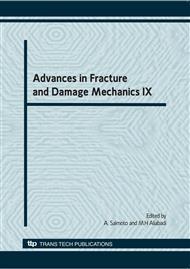p.829
p.833
p.837
p.841
p.845
p.849
p.853
p.857
p.861
Molecular Dynamics Study on Interaction between Voids for Pure Aluminum
Abstract:
The voids in pure Aluminum always exit in the manufacturing process. The Modified Embedded Atom Method (MEAM) potential is employed in the molecular dynamics (MD) simulation at atomic scale to investigate the interaction between voids under the impact loading for pure Aluminum. The distance between the voids distributed along the loading orientation affects the failure mechanism seriously. The results show that there are 3 kinds of mechanisms with the change of the distance between voids: 1) coalescence takes place within a critical distance between voids under extra loading, 2) when the distance between voids reaches a certain value, each void cracks at 4 locations along with the slide direction <110> of face-centered cubic (fcc), respectively, 3) a stress shield zone appears when the ligament between the voids is at the size between the cases mentioned above, which brings out the phenomena that each of the voids cracks only at 2 locations, and no crack appeared at the stress shield zone.
Info:
Periodical:
Pages:
845-848
Citation:
Online since:
November 2010
Authors:
Price:
Сopyright:
© 2011 Trans Tech Publications Ltd. All Rights Reserved
Share:
Citation:


